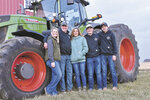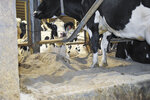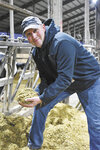


How many times a day do you milk, and what is your current herd average, butterfat and protein? We milk three times per day with a current rolling herd average of 34,300 pounds with a butterfat of 4.35% and 3.23% protein.
Describe your housing and milking facility. Our cows are milked in a double-11 herringbone parlor retrofitted into our original tiestall barn, and they are housed in a naturally ventilated, sand-bedded, head-to-head, 4-row freestall barn.
Who is part of your farm team, and what are their roles? Kraig and Rachelle are the owners and daily operators of the dairy. Kraig fills the overall farm manager role. Rachelle’s titles include calf manager and CFO as well as overseeing the herd health and youngstock programs. Kraig’s dad, Roger, does the bulk of the feed mixing and delivering. Blake is learning to coordinate the agronomy aspect of the business. Elizabeth works at another dairy but pitches in with harvest and chores when available. Brodie fills in as support staff in multiple areas when not busy with high school and FFA. We’re supported by a team of nine full-time and three part-time employees as well as a great team of advisors on our Minnesota Dairy Initiative team and an awesome translator.
What is your herd health program? Herd check is performed via ultrasound with the veterinarian every other week. Cows are checked for 30-day and 60-day pregnancies. The 180-day pregnancies are confirmed via milk sample during DHIA testing. Vaccinations are mainly administered during the dry period for cows or pre-calving window for heifers with the exception of a fall respiratory vaccine, Inforce at freshening and Bovi-Shield Gold during the fresh period. Our heifers have a complete vaccination program prior to reaching one year.
What does your dry cow and transition program consist of? Dry cows and heifers are housed in sand-bedded free stalls for the far-off dry period, receive one ration during the dry period and are dry for an average of 58 days. The ration is a low-energy, high-fiber ration with straw and added water for palatability. At approximately 30 days pre-fresh, heifers and cows are moved onto bedded packs. The packs are bedded daily with cornstalk bales and checked every hour around the clock for newborn calves. After calving, cows are moved into the fresh pen where they stay for approximately 20 days before moving into one of the big group pens based on lactation number.
What is the composition of your ration, and how has that changed in recent years? Our lactating ration is approximately 20 pounds dry matter corn silage and 7 pounds dry matter baleage. We also feed canola, whole cottonseed, a protein mix and fine-ground corn. Three years ago, we switched to making baleage instead of haylage as way to maximize our feed storage space. This has allowed us to pick and choose hay cuttings and quality on an ongoing basis to maximize the best quality for the lactating cows. We also went away from feeding high-moisture corn to feeding fine-ground dry corn year-round. This provides a more consistent feed quality and minimizes gut issues.
Tell us about the forages you plant and detail your harvest strategies. We plant conventional Pioneer alfalfa and aim to take our first cutting in late May. Every 28 days after that, or when we see buds, we take an additional cutting. On average, we get four cuttings per season. For baleage, our window for baling is 45%-55% moisture. The baleage is wrapped in long rows with an inline wrapper. Our corn silage is all Pioneer brown mid-rib varieties. Our target for moisture on corn silage at harvest is 67%-68% moisture. All of our silage is stored in bunkers, and we use an Agromatic packer behind the second pack tractor to improve packing density. We also line the sidewalls with plastic and use a vapor barrier film as well as buchneri silage inoculant. As the final step, we use cut off sidewall tires on the entire surface, tire touching tire. We own all our own forage equipment which allows us to make optimal harvest decisions.
What is your average somatic cell count and how does that affect your production? Our SCC is 70,000. If we can keep our SCC low and prevent mastitis, it gives us the opportunity to make more culling decisions based on low production instead of mastitis, therefore increasing average herd production.
What change has created the biggest improvement in your herd average? We saw the biggest improvement when we moved to milking three times a day. The additional pounds generated combined with the reduced incidents of mastitis were a big win for our dairy.
What technology do you use to monitor your herd? To increase our level of management, we use multiple technologies every day. All the cows and heifers breeding age and up have CowManager tags to monitor health and heat events. In the parlor, we utilize BouMatic SmartDairy to record daily milk weights, and we tie all that together with DairyComp 305 and DHIA testing to help us make informed decisions.
What is your breeding program, and what role does genetics play in your production level? Our voluntary waiting period is 70 days, and all cows are enrolled in a double ovsynch program with timed A.I. for first breeding. Pens are walked daily, and CowManager is used to identify standing heats following the initial timed A.I. Open cows are confirmed via ultrasound at herd check and either enrolled into a resynch program or CIDR-synch program. Heifers are bred on standing heats starting at 13.5 months of age. Genetics play an instrumental role in our production. We have utilized A.I. since 1973, and we are always working on advancing our genetics. Since 2018, we have been genomic testing our heifers and using that information to create individualized mating decisions.
List three management strategies that have helped you attain your production and component level. Three-times-a-day milking, producing and feeding top quality forages, and utilizing sand bedding.
Tell us about your farm and your plans for the dairy in the next year. Prairie Dairy has been operated by the Krienke family at this location since 1864, and the current family team consists of Kraig and Rachelle plus their kids Elizabeth, Blake and Brodie, as well as Kraig’s dad, Roger. In the next year, we plan to initiate the first phase of a expansion by constructing additional dry cow facilities and a new calf barn.
Comments
No comments on this item Please log in to comment by clicking here